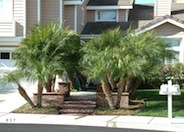
Common name:Bougainvillea, Barbara Karst
Botanical name:Bougainvillea 'Barbara Karst'
The large amount of flamboyant color on this species creates a wonderful accent in a garden. Varieties can be in bush or vine form; colors vary. Once established, they tend to be carefree. All varieties are susceptible to frost damage. The 'Barbara Karst' variety blooms bright red in full sun; more crimson if in shade. It blooms early and long.

Common name:Pygmy Date Palm, Roebelin Palm
Botanical name:Phoenix roebelenii
This tree will grow to about 10' tall and has dark green, spiny petiole foliage. It does well in full sun to heavy shade; it likes moderate to heavy irrigation, but can take periods of dryness.

Common name:Creeping Fig
Botanical name:Ficus pumila
This is one of the few plants that can attach itself securely to wood, masonry, or metal. Because there is no limit to its size, it can overcome an entire buliding. It is most often found in colder climates. This vine will not climb on the south or west walls.

Common name:Calla Lily
Botanical name:Zantedeschia aethiopica
This perennial will grow 2'-4' tall and has large, glossy green leaves with beautiful cream or white flowers that bloom in spring and sometimes even summer.

Common name:London Plane Tree
Botanical name:Platanus X acerifolia
London Plane Tree is a fast growing, deciduous tree that reaches a size 40'-80' high by 30'-40' wide. Its leaves are 3-5 lobed, with a width of 4"-10". This plant is tolerant of most soils, smog, dust and reflected heat.

Common name:Garden Nasturtium
Botanical name:Tropaeolum majus
This annual groundcover/vine and will grow less than 1' tall, but will spread and climb up to 6' tall. Nasturtium has 2" light green leaves with edible, red, orange, yellow, or white flowers that are in constant bloom throughout the warm season. This plant usually reseeds, with new plants emerging in early spring.
The Right Plant Right Place
Putting the right plants in the right places in the right groupings is both the challenge and art of good landscape design.
Click in the green box for more information
| Designer: | Big Beam Vine Support |
Photographer: GardenSoft |
Soils and Compost:
Practice grass-cycling by leaving short grass clippings on lawns after mowing, so that nutrients and organic matter are returned to the soil.
Integrated Pest Management:
Drip and other smart irrigation delivers water directly to roots, allowing no excess water for weeds.

